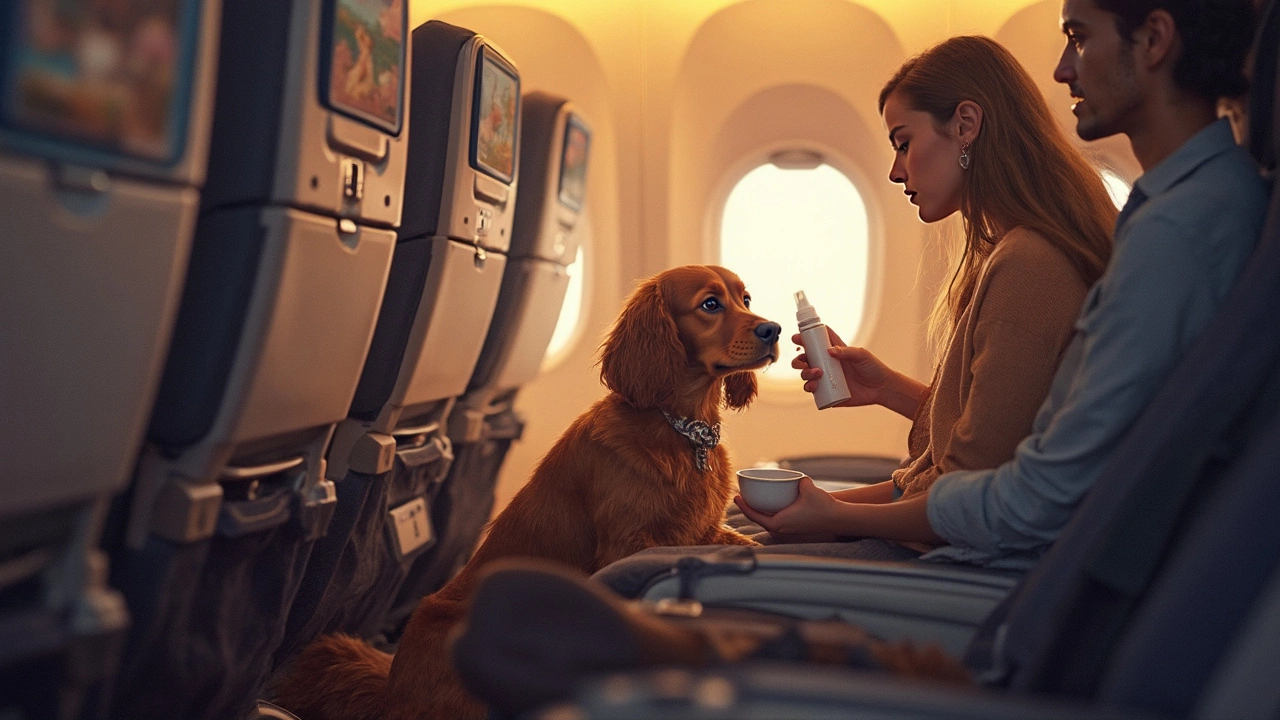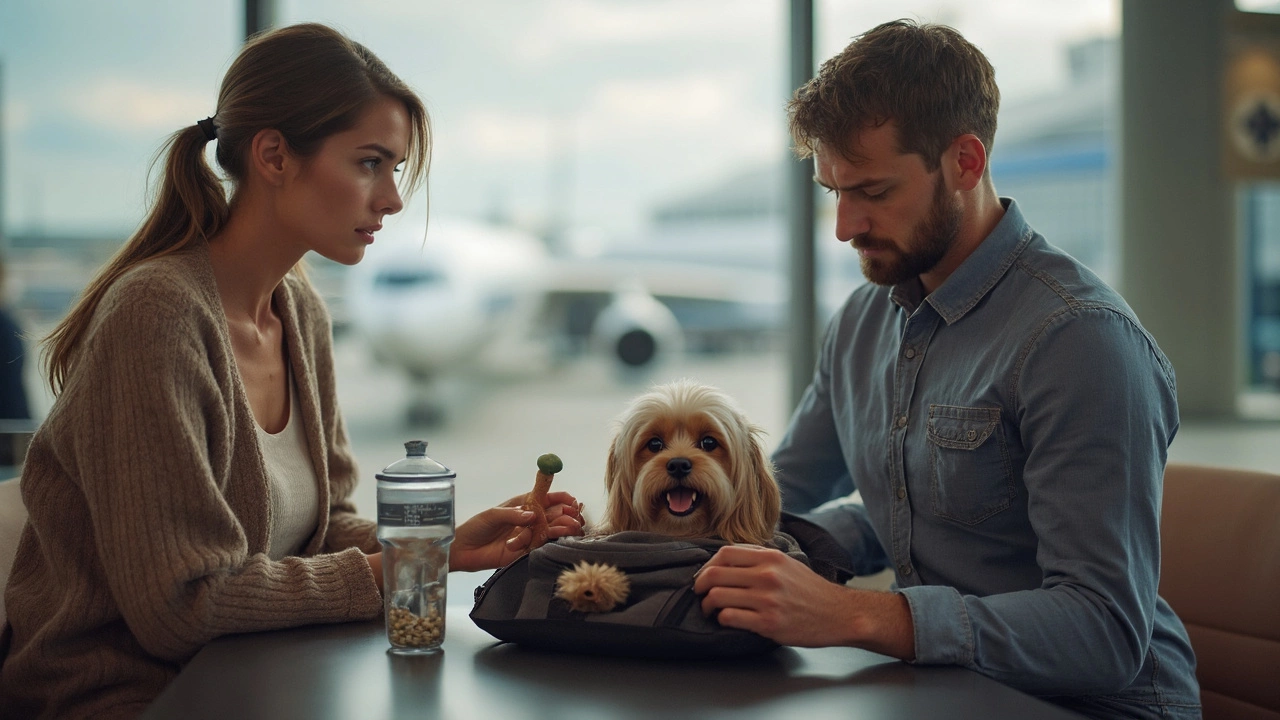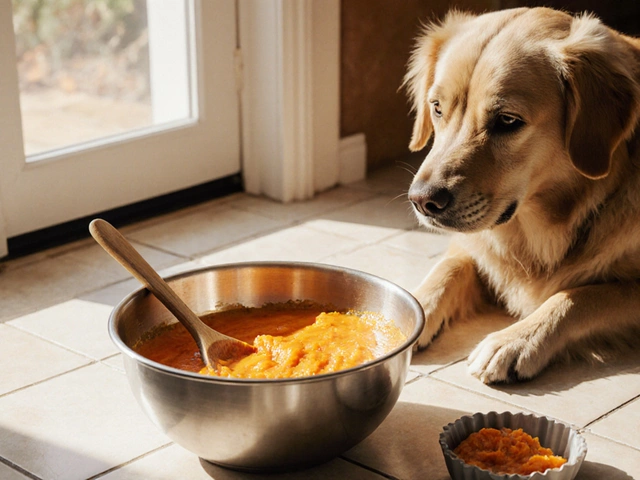Getting ready to fly with your dog? Don’t leave things to chance—what you give your pup right before takeoff can make or break the trip for both of you. Most people worry about their dog getting sick, anxious, or just plain miserable at 30,000 feet. Truth is, it’s not just about what you feed them on the big day, but when.
Here’s one big thing: vets usually say don’t feed your dog a full meal within four hours of your flight. You want to keep tummies settled and bathroom breaks minimal. Small, bland snacks are okay if your pup gets extra anxious without food. And always let them drink water before the flight, though not so much that they’ll need a bathroom break mid-air. Ice cubes can be a smart way to keep your dog hydrated without overdoing it on liquids.
Some folks want to give their dogs calming meds or supplements. But different dogs need different things—and not every product is safe. Before you pick anything off the shelf or try a 'natural' remedy, talk with your vet. They’ll know what works for your dog’s age, breed, and health.
- Food, Water, and Timing: What Your Dog Needs Before a Flight
- Calming Methods: Medications, Naturals, and What Works
- The Don’ts: What Not to Give Your Dog Before Flying
- Preparing Your Dog for a Smooth Flight Experience
Food, Water, and Timing: What Your Dog Needs Before a Flight
Getting your dog prepped for air travel isn’t just about tossing treats in their carrier. What and when you feed your dog before a flight really matters. Feed them too close to takeoff and you could end up with a pukey pup. Skip food for too long, and you risk them getting shaky or cranky.
The golden rule most vets share: give your dog their last full meal about four hours before you head to the airport. This helps avoid an upset stomach or an accident in the crate. If your flight is super early, a half-portion or just a small snack can work. For small breeds or puppies (who burn calories faster), slipping them a few bites of plain boiled chicken or their regular kibble could keep their blood sugar up without overloading their belly.
Water is a different story. You shouldn’t leave your dog dehydrated, but flooding their system can mean bathroom emergencies. Most owners stick to giving water up until an hour before security or check-in. For long flights, especially when dogs must travel in cargo, toss a frozen bowl of water in the crate—it’ll thaw slowly and give them access to drinking water without spilling everywhere. Some collapsible water bottles with non-spill attachments can clip to the inside of crates, which helps a lot on multi-hour trips.
"For most dogs, the biggest travel risks are dehydration and stomach upset. Balancing water intake—and timing the last meal—keeps travel safe and easier for both dog and owner." — Dr. Brooke Butler, DVM, American Veterinary Medical Association
If you’re not sure about timing, here’s a quick layout:
| Dog Size | Last Meal (hours before flight) | Water Cut-off (hours before flight) |
|---|---|---|
| Toy/Small | 3-4 hours | 1 hour |
| Medium/Large | 4-5 hours | 1-2 hours |
One thing people forget is treats. Don’t give your dog heavy, fatty, or new treats the day of travel—it’s not the time to experiment. Have a couple of their regular treats on hand just for rewarding them at the airport or during check-ins.
- Monitor your dog for pre-flight nerves—tense pups might not want to eat or drink much at all.
- Skip table scraps and rich foods for at least 24 hours before flying.
- Bland diets are safer for nervous tummies. Think plain chicken, rice, or their usual dry food.
- If your dog’s on special medication with food, talk to your vet about any needed timing changes.
Nailing food and water in the hours before your dog travel adventure keeps your furry buddy healthy and saves you messes and headaches once you’re wheels up.
Calming Methods: Medications, Naturals, and What Works
If your dog’s a nervous flyer, you’re definitely not alone. But before tossing any random pill or herb into their travel bag, it’s smart to know what actually works—and what could put your furry friend at risk.
Let’s break it down. There are prescription meds, over-the-counter options, "natural" products, and a few simple tricks you can try. Here’s what stands out:
- Prescription medications: These include drugs like Trazodone, Gabapentin, and sometimes certain antihistamines like hydroxyzine, all of which need a vet’s sign-off. They can seriously help with anxiety but only use them if your vet gives the green light. Most vets want to do a trial run before travel to check for side effects.
- Over-the-counter options: Benadryl (diphenhydramine) is sometimes used for mild sedation, but it works for some dogs, not all. Never guess the dosage; too much can harm your dog, and it’s not safe for certain breeds.
- Natural remedies: Lots of people try CBD treats, calming pheromone sprays, L-theanine bites, or even a thunder shirt (that snug vest that feels like a hug). The science is hit or miss, but some owners swear by them. Again, check with your vet so nothing messes with your dog’s regular meds or health issues.
- Familiar scents: Bringing along a blanket or toy that smells like home can work wonders for anxious pups (seriously). Sometimes simple is best!
Traveling with pets is big business, so there’s a ton of stuff marketed as must-haves for flying with dogs. Not all of it holds up. According to the American Veterinary Medical Association:
“Sedating animals during air travel is generally not recommended, as it can increase the risk of heart and respiratory problems.”
What does that mean for you? Don’t assume the strongest meds are always the answer. For some dogs, calming sprays or treats are enough. For others, their regular toy and being near their person (if flying in the cabin) calms them down more than any pill.
Here's a quick comparison of common calming methods and what pet pros say about their effectiveness before a dog travel flight:
| Method | Vet Approval Needed? | Pros | Cons |
|---|---|---|---|
| Prescription Medications | Yes | Effective, predictable if tested first | Side effects possible, not for all dogs |
| Benadryl | Strongly advised | Easy to get, mild sedation | Not always works, some risks |
| CBD Treats | Recommended | Non-prescription, some dogs relax | Little regulation, inconsistent results |
| Pheromone Sprays | No | Safe, easy to use | Subtle effect, doesn’t help all dogs |
| Familiar Scents (toys, blankets) | No | No side effects, comfort of home | Works best with mild anxiety |
No matter what you pick, do a test run at home first. You definitely don’t want to learn your dog reacts badly to something when you’re already at the gate. And always talk through your options with your vet—they know your dog’s real health picture, not just what’s trending online.

The Don’ts: What Not to Give Your Dog Before Flying
When it comes to flying with your dog, a few wrong moves can turn an already stressful event into a disaster. Some foods, meds, and even handy-sounding tricks just aren’t safe in the air. Let’s break down what to skip and why.
- No heavy or greasy foods: Avoid dog treats or table scraps right before flying. Fatty foods can upset your dog’s stomach, raising the risk of vomiting or diarrhea in the crate.
- No full meals closer than 4 hours before takeoff: Eating right before the flight means a greater chance your dog will need an in-flight potty break (and good luck with that at 35,000 feet).
- No sedatives unless your vet says so: Airlines and the American Veterinary Medical Association warn against tranquilizers. Sedated dogs can have breathing trouble at high altitudes. In fact, about half of the incidents involving pet deaths in cargo have been tied to sedation, based on a 2023 AVMA report.
- No new treats, supplements, or medications: This is not the time to experiment. New products might trigger allergies, stomach problems, or unpredictable reactions. Stick to their regular food and vet-recommended options.
- No chocolate, caffeine, or xylitol: These are all toxic to dogs and can cause life-threatening problems, so make sure nothing accidentally slips into their pre-flight snack.
- No excessive water chugging right before boarding: Hydration is good but too much can mean accidents mid-flight. Offer a few sips or small ice cubes instead.
To keep it clear and simple, here’s a quick comparison of what’s safe and what’s not before your flight:
| Item | Safe or Unsafe? | Why? |
|---|---|---|
| Small bland snacks (4+ hours before) | Safe | Won't upset stomach, minimal bathroom risk |
| Sedatives/tranquilizers (not vet-approved) | Unsafe | Breathing issues, AVMA says avoid |
| Hearty meal (≤4 hours before) | Unsafe | Increases risk of vomiting or accidents |
| Ice cubes or small water sips | Safe | Prevents dehydration, doesn’t overload bladder |
| Chocolate or xylitol snacks | Unsafe | Toxic and potentially deadly to dogs |
| New supplements/meds | Unsafe | Unpredictable reactions, not tested for your dog |
Always remember: just because a calming aid, treat, or remedy says it’s "natural" or is recommended online doesn’t mean it’s safe for your pup, especially around dog travel. Your vet should be the final word.
Preparing Your Dog for a Smooth Flight Experience
If you want your dog’s travel day to go as smoothly as possible, a little prep work goes a long way. Dogs pick up on our stress, so try to keep your pre-flight routine calm and predictable. It’s a good idea to get your dog used to their carrier weeks before flying. Let them nap, eat, and play in it so it feels like a regular, safe space and not a scary box.
On flight day, exercise is your best friend—literally. Take your dog for a long walk or play session before you head to the airport. Tired dogs are usually calmer and less likely to get antsy in their crate. If your dog gets car sick or nervous on the way to the airport, drive them on practice runs so the whole trip feels familiar by the time travel day comes.
With so many rules, it helps to double-check your airline’s pet requirements. Airlines often have limits on crate size, ventilation, and where pets can ride. Not all airlines let pets fly in the cabin. Check and recheck—it could save you a huge headache at the airport.
- Make sure all pet documents are ready—health certificate, vaccination records, and tickets with your dog’s info.
- Attach a clear ID tag to the crate and your dog’s collar with your current contact details.
- Pack a bag with the essentials: leash, waste bags, favorite toy, lightweight blanket, and any regular medications.
Choosing what to put in your dog's carrier matters. Their favorite blanket or t-shirt that smells like you can ease anxiety. Avoid toys with squeakers that might annoy fellow travelers.
Most airlines recommend you arrive at least two hours early if you’re flying with your pup. This gives you time for bathroom breaks and any last-minute paperwork. Right before you zip up the crate, offer another chance to pee outside—even the smallest bladder can surprise you under stress.
It helps to know stats on pet travel safety and rules for airline trips. Here’s a quick comparison of major U.S. airlines’ pet policies:
| Airline | In-Cabin Pets? | Crate Size Limit | Health Certificate? |
|---|---|---|---|
| Delta | Yes | 18x11x11" | No (domestic), Yes (international) |
| American | Yes | 19x13x9" | No (domestic), Yes (international) |
| United | Yes | 18x11x11" | No (domestic), Yes (international) |
And here’s the key: don’t guess or take advice from just anyone on what to give your dog. Always ask your vet. The best prep for dog travel is really a mix of good packing, routine, and expert advice. That way, you and your furry buddy can focus less on worries and more on the adventure ahead.





